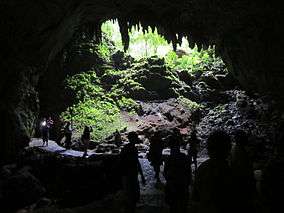Puerto Rican quail-dove

| Puerto Rican quail-dove | |
|---|---|
 | |
| Bones of the Puerto Rican Quail-Dove | |
| Fossil | |
| Scientific classification | |
| Kingdom: | Animalia |
| Phylum: | Chordata |
| Class: | Aves |
| Order: | Columbiformes |
| Family: | Columbidae |
| Genus: | Geotrygon |
| Species: | G. larva |
| Binomial name | |
| Geotrygon larva (Wetmore, 1920) | |
| Synonyms | |
|
Oreopela larva | |
The Puerto Rican quail-dove (Geotrygon larva) is an extinct species of dove from the genus of quail-doves (Geotrygon). It is only known by subfossil material from the Holocene.
Remains of the Puerto Rican quail-dove were unearthed in the caves Cueva Clara and Cueva Catedral near Morovis, in the cave Cueva Toraño at Utuado and in a kitchen midden near Mayagüez on Puerto Rico. The holotype, a tarsometatarsus, was discovered in July 1916 by zoologist Harold Elmer Anthony in the cave Cueva Clara.
According to Alexander Wetmore[1] who described this species it was related to the grey-fronted quail-dove (Geotrygon caniceps) which occurs on Cuba and on the Dominican Republic. However, the tarsometatarsus of the Puerto Rican quail-dove is longer than in the grey-fronted quail-dove. Compared with the ruddy quail-dove (Geotrygon montana), which occurs on Puerto Rico too, the tarsometatarsi are more slender.
The amount of the unearthed material led to the assumption that the Puerto Rican quail-dove might have been a common bird before the arrival of the first settlers. Probably it became a victim of the extensive deforestations.
Notes
- ↑ Alexander Wetmore: Five New Species of Birds from Cave Deposits In Porto Rico In: Proceedings of the Biological Society of Washington, 1920:p 79–80
References
- Alexander Wetmore: Five New Species of Birds from Cave Deposits In Porto Rico In: Proceedings of the Biological Society of Washington, 1920:p 79–80
- Alexander Wetmore: Bird Remains from the Caves of Porto Rico In: Bulletin of the American Museum of Natural History No. 46, 1922:p 316–317
- Alexander Wetmore: An Additional Record for the Extinct Porto Rican Quail-Dove In: Auk Vol. 40 (2), 1923:p 324
- Alexander Wetmore: Scientific Survey of Porto Rico and the Virgin Islands. Vol. 9, pts. 1-4. New York Academy of Sciences, 1927, p 405–406
- Michael Walters & Julian Pender Hume: Extinct Birds. Poiser Monographes (A & C Black), 2012. ISBN 978-140-815-725-1. p 147.